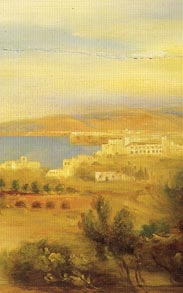Carl Blechen
The painter Carl Blechen, son of a tax official from Regensburg and mother from Wendisch, was born in Cottbus in 1798. On finishing school, the 16-year-old embarked on an apprenticeship as a banker in Berlin. His increasing dissatisfaction with this profession and intensive preoccupation with painting in his spare time, prompted the talented youth to enrol at the Royal Academy of Arts in Berlin. On the recommendation of Karl Friedrich Schinkel, who recognized the artist's outstanding promise at an early stage, he was given a job as a scene painter at the Königsstädter Theatre in Berlin's Alexanderplatz. The creation of programmes for romantic operas, medieval knight plays and melodramas had a perceptible influence on Blechen's later work. Visitors at the annual exhibitions of the Berlin Academy admired his "rich imagination". The sale of a few paintings enabled him to travel to Italy for a year in 1828. This trip had a very important influence on his artistic development. Some of his finest works were created there far away from the everyday routine and under the strong colour-fading midday light of the south. Blechen portrayed the nature of the south in his paintings as a landscape structured by light and shadow, whose solid outlines were dissolved by the shimmering heat. The artist's impartial perspective focused on the elemental powers of nature which triumph over events created by history. This unconventional point of view was exceptional in the German art of his time. On his return from Italy Blechen felt armed for his further advance on the Berlin art scene. He not only achieved success with his paintings but was also appointed professor of landscape painting at the Academy of Art. King Friedrich Wilhelm III acquired paintings by Blechen and commissioned two paintings of the palm house on the Pfaueninsel island in 1832. A psychiatric disorder resulted in the artist's death in 1840 at the age of 42.
